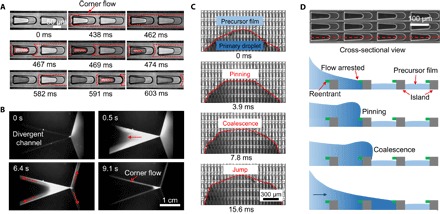Fig. 2. Microscopic spreading dynamics.

(A) Schematic depiction of the corner flow induced by the side-channels and eventual filling-up of the cavities with reentrant structure. (B) To demonstrate the corner flow, we created two diverging channels using two nonparallel glass slides. As a water droplet containing 0.1-μm fluorescent particles is placed in the mouth of a channel (0 s), the liquid flows fast along all the available corners (indicated by the red arrow) and fills partially the entrance region of the channel. However, as flow continues along the corners, this accumulated liquid is depleted, indicating the role of the corner flow on the liquid transport. (C) Visualization of the time-dependent flow behavior of a water droplet on liquid diode. As the precursor film continues to flow ahead of the primary droplet, the spreading liquid accumulates to form a nearly straight wetting front as a result of contact line pinning of the advancing edge (3.9 ms). Subsequently, the primary droplet coalesces with the precursor film, and the straight edge eventually jumps like an avalanche (7.8 and 15.6 ms), resulting in a fast forward flow. (D) Schematic drawing showing the spreading dynamics of a primary droplet in the forward direction, which consists of pinning of the advancing edge, coalescence, and subsequent hydraulic jump with the precursor film accumulated in the reentrant cavity. The area in green corresponds to the reentrant structure.
